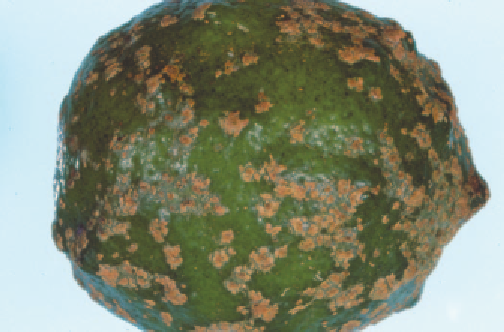Agriculture Reference
In-Depth Information
LEMON SCAB
■
Cause
The fungus
Sphaceloma (Elsinoe) fawcettii
var.
scabiosa
.
Symptoms
Raised, grey to light brown, corky scabs are the main
symptoms on leaves, twigs and fruit. Affected leaves may
be distorted. Symptoms may appear within four to six
days after infection.
Source of infection and spread
Old scabs on leaves, twigs and fruit (including the
peduncle, which may remain on the tree after harvest)
provide the main sources of inoculum. Spores produced on
these scabs are spread by wind and rain. Leaves are most
susceptible as they emerge from the bud and become
resistant as they mature. Fruit remain susceptible to
infection for about three months after petal fall. Infection
requires only five to six hours of leaf wetness and
temperatures 21-30 ° C.
Fig 6.38 A lemon with typical scab symptoms.
particularly on rough lemon seedlings, and nursery
trees propagated on these stocks are a source of
contamination for new orchards. While finding scab
symptoms on lemons is not considered unusual, finding
scab symptoms on any other citrus variety should be
investigated further by a plant pathologist. In particular,
scab symptoms found on sweet oranges should be
reported, so testing for the exotic fungus
Elsinoe australis
can be undertaken.
Importance
Lemon cultivars are the most susceptible, being
particularly problematic during the summer crop. The
disease can be a serious problem in nurseries,
Management
•
Apply the recommended registered protectant
fungicides. Fungicide programs used for black spot and
brown spot control will be effective.
Prune infected twigs and fruit peduncles after harvest.
•
SEPTORIA SPOT
■
Cause
The fungus
Septoria citri
.
Symptoms
Small, round, sunken spots 1-2 mm in diameter develop
on infected fruit in late winter. The light tan spots with a
greenish margin become reddish brown to pale brown as
the fruit matures. Small black fruiting bodies (pycnidia)
of the fungus (just visible to the naked eye) may form
in the spots. On infected fruit exposed to frost, spots may
enlarge and join to produce brown-to-black, scald-like
patches. Symptoms may occur on fruit on the tree or
in storage. On infected leaves, small, blister-like,
brown-to-black spots with a yellow halo develop on
the lower leaf surface.
Fig 6.37 Scab symptoms on leaves. This diseases causes distortion in
new growth and corky scabs on leaves and twigs.













